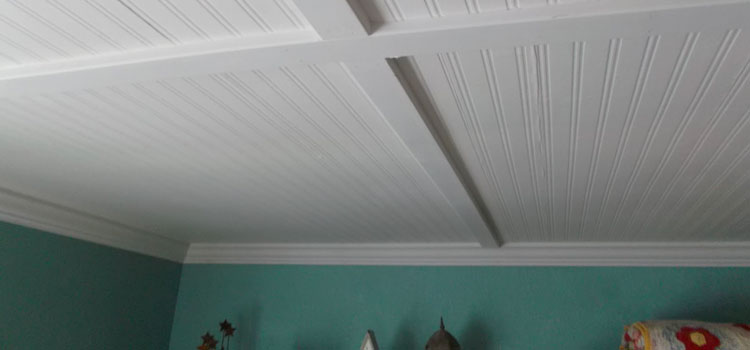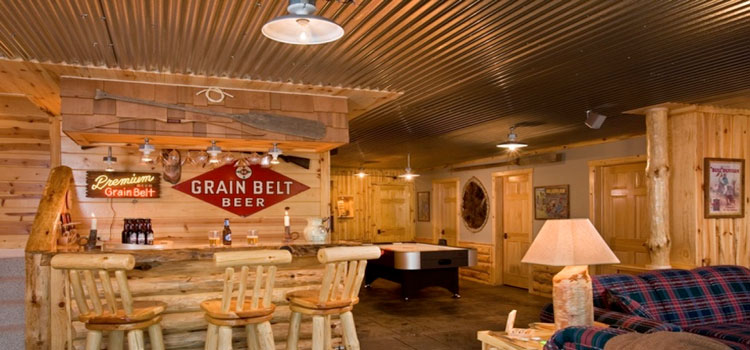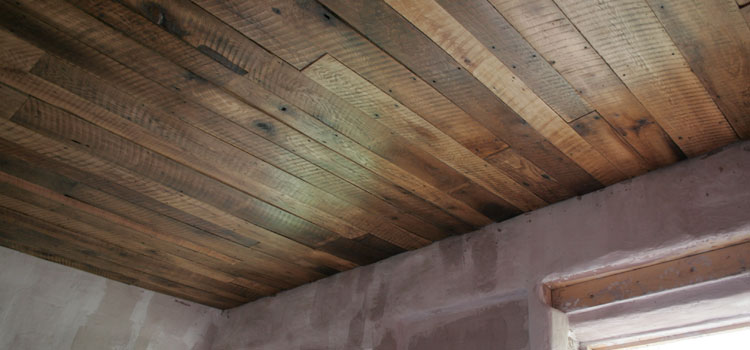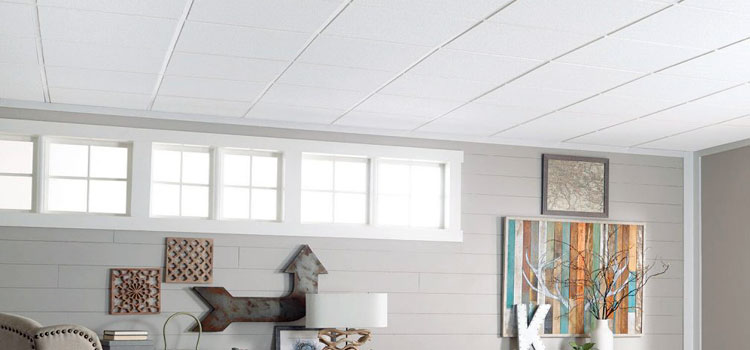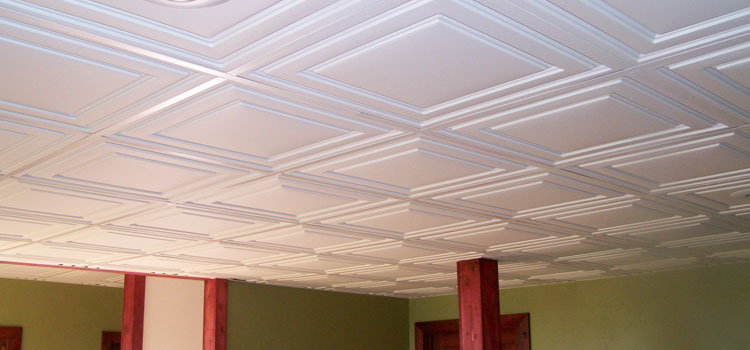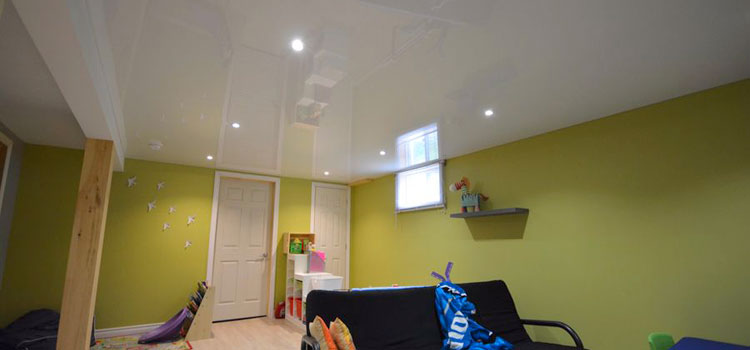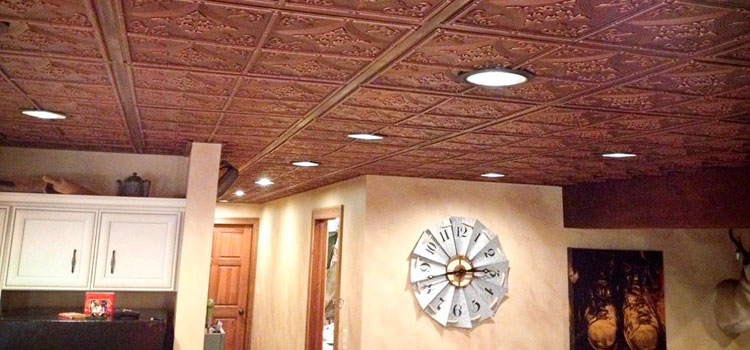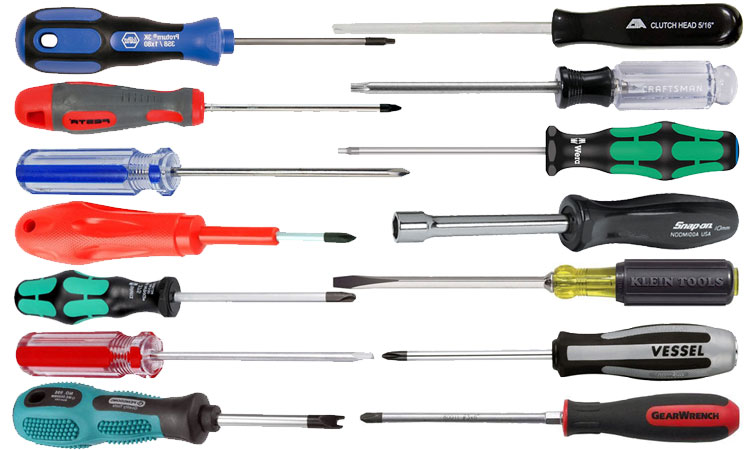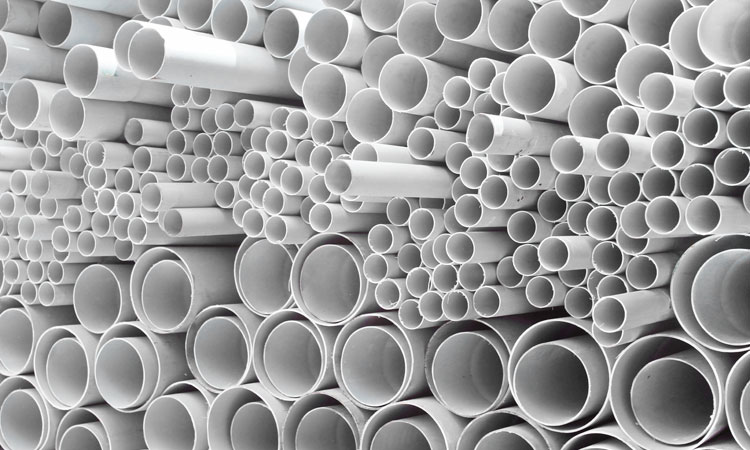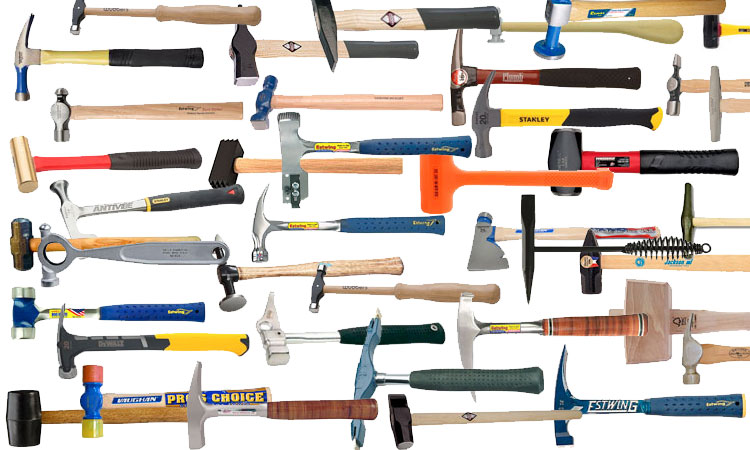10 Cheap Basement Ceiling Ideas for Standard and Low Heights
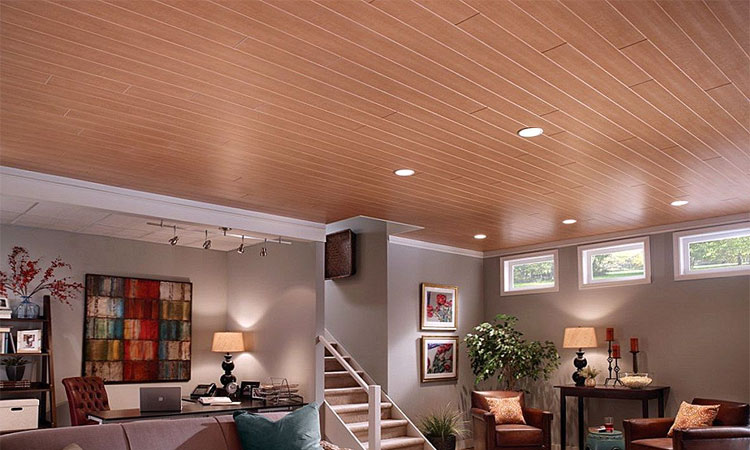
Once upon a time, people added basements and attic spaces to their homes to create additional storage space. As generations passed, these extra rooms began to see more and more activity. Nowadays, it’s common to have a finished basement or attic that functions as additional living space.
This new use for basements comes with a dilemma, however. Most basements have exposed beams, wires, and ductwork. These can not only make cleaning more difficult, but they tend to be an eyesore when guests are over.
The following solutions can be used to create the finishing touches on your basement ceiling, be it low-lying or standard height. Best of all, most of these methods will work on a small budget, making it easy to add the cost to any existing finishing plans.
Low Basement Ceiling Ideas
Sometimes height comes into play when choosing a good ceiling material. These choices require minimal space and are perfect for newer homes where you can attach a ceiling directly to the support beams.
#1 – Beadboard
This style of wood paneling is extremely popular in Cape Cod-style homes, although it can be used with most architectural styles. Most commonly used vertically on walls, the panels can also be placed horizontally and are a very popular material for porch ceilings.
Tongue-in-groove beadboard comes in individual boards that fit together, while sheet beadboard comes in panels of 4 to 8 feet in length.
The individual boards come in two standard widths of 1.5 and 3 inches, although it’s possible to have custom widths made. Some homeowners prefer to do a mix using tongue-in-groove boards, with several 1.5 inch boards between the 3 inch boards or alternating in sizes.
Beadboard can be quite time-consuming to place, as it’s installed one board at a time onto a plywood base. The resulting surface may be painted or varnished, making it perfect for a wide range of tastes, from classy to classic.
#2 – Corrugated Metal
Do you remember driving past a farm and seeing the metal roofs? Well these roofing tiles are an unexpectedly popular alternative for traditional ceiling materials. You can purchase recycled metal tiles from barns to gain a rustic look, or purchase them new for that ultra-modernist feel.
One pleasant bonus to using corrugated metal is its ability to reflect light, making it ideal for both normal height and low ceilings. This also makes it a great idea for a garage ceiling.
#3 – Drywall
Perhaps the cheapest and most widespread ceiling solutions, drywall creates a smooth, attractive living space. Simply apply a coat of primer and a coat of your favorite paint color for a nice finished look.
Paired with recessed lights, the surface gives the ultimate modern or futuristic appeal. It can also be easily cut and fitted during household repairs.
Unfortunately, drywall can also have a few downsides. Termite and ant infestations will often target drywall. Additionally, drywall is easily damaged by moisture. Keep these factors in mind when considering this material for your basement.
#4 – Painted Exposed Beams and Pipes
Highly popular in coffee shops and other modernist locations, a couple coats of paint can completely change the feel of an exposed ceiling. Some people choose to paint exposed ductwork, while others prefer to polish the surface for some nice contrast.
The only downside to this alternative is that is can be more difficult to apply when there are exposed wires present. You will likely want to cover these with a thin casing or cover of plywood.
Related: 4 Ways to Make Plywood Waterproof
#5 – Wood Paneling
Similar in final appearance to beadboard or a good wooden floor, this ceiling option provides a classic look without all the work of fitting individual boards.
Available in a wide range of finishes and styles, these panels may be rigid or flexible, with the latter allowing you to panel archways and other curved surfaces.
One of the advantages to using wood paneling is the ability to attach panels directly to the support beams, costing minimal height degradation. The numerous design options also make it easy to create a unique feel that will fit just about any theme.
#6 – Wood Planks
Somewhere between the single-board construction of beadboard and the visual adaptability of wood paneling lies the wood plank ceiling. These planks fit together using a tongue-in-groove approach and are attached metal runners.
Not only can they be used to cover an exposed ceiling, but can also be installed directly onto an existing ceiling such as popcorn or drywall.
Lightweight and sturdy, wood planks make an excellent ceiling that can be painted or stained for the desired effect. As an added bonus, it’s slightly cheaper than beadboard, and it’s an easy DIY project compared to many other ceiling types.
Standard Height Basement Ceiling Ideas
Ideally, your basement ceiling is standard height. This allows you to easily conceal the inner workings of your home in a more seamless shell. Some of these methods will create height degradation (i.e. they make the ceiling lower) and are thus poor choices for low ceilings.
#7 – Drop Ceiling Tiles
One of the most popular solutions for adding ceilings in older homes, drop ceilings provide an attractive and cost-effective solution at the cost of height.
Many home renovations use drop ceilings to make old homes feel more cozy. They are also the best option in older basements where the wiring and pipes may be located below the beams.
Drop ceilings also provide long-term savings. If a tile is damaged, you can simply lift it out of the frame and pop a new panel in instead of fixing the entire ceiling. You can also get lighting fixtures that fit easily into the frame, providing ample light without protruding into the room.
Two other reasons for choosing a drop ceiling are the superior noise dampening capabilities and the versatility of modern frames. Modern drop ceilings can range from the traditional white foam or particle board panels to classy tin tiles, allowing them to fit into most decorative styles.
DecorativeCeilingTiles.com has probably the best selection of drop ceiling tiles but HomeDepot.com is a good option as well.
#8 – PVC Tiles
Chances are, when you hear the term PVC, the image of ceiling tiles never crosses your mind. That’s because this durable vinyl material is most often used to mimic other materials, from particle board to tin and copper.
The advantage is that PVC is extremely durable; water mildew, and mold resistant; lightweight; and won’t sag. Some types of interlocking garage floor tiles are even made out of this material.
Most PVC tiles are designed for use with a suspension frame, although you can purchase tiles that may be attached directly to a plywood or drywall base. You will need the latter when working with lower ceilings.
Once again, check out the huge selection of PVC tiles at DecorativeCeilingTiles.com or the few styles that HomeDepot.com carries.
#9 – Stretch Ceiling
Sometimes you want something truly unique. Stretch ceilings offer this option, with the ability to form unusual shapes and provide colors and lighting options that are difficult to replicate with paint and traditional lighting.
With this material, you can create arches and domes with no visible light source, or go for a design that will be the talk of the town. Stretch ceilings also offer excellent soundproofing options, making it a good choice for home theaters.
#10 – Tin Tiles
Made famous in the pubs of yore, tin tile ceilings are hardly a new idea. The material is intricately worked, yet very thin, making it easier to add insulation with minimal height degradation.
Use these tiles to create a classy, classic living space. Individual tiles may set you back as little as $6, but the full cost for a ceiling and labor can get quite costly compared to other options.
There are three types of tin ceiling, as well as three coating options. The traditional nail-up tiles require a plywood base, or you can choose a drop ceiling variant at the same cost per tile.
More expensive per tile, a snap-together version provides a seamless appearance and can be attached to almost any surface. From cheapest to most expensive, all three tile types may be given an uncoated, powder-coated, or artesian finish.
Note: Copper tile is also available, but the cost is much higher, making it a poor choice for most homes.
Comparing Ceiling Materials
| Material | Height Degradation | Budget Estimate (200 sq. ft.) | Special Notes |
|---|---|---|---|
| Beadboard | Low | $700-2,000 | Great effect when also used as wainscoting |
| Corrugated Metal | Low | $1,000-3,000 | Brightens the room |
| Drop Ceiling | High | $450-1,500 | Excellent sound absorption for home theaters |
| Drywall | Low | $400-500 | Easily cut and repaired |
| Painted | None | $30-$100 | Poor choice for ceilings with exposed wires |
| PVC Tile | Low-Mid | $200-$1,800+ | Can mimic other ceiling materials |
| Stretch Ceiling | Varies | $1,000-1,600 | Can form flat surface or be molded into shapes |
| Tin Tile | Low-Mid | $1,000-2,500 | Add mirrored shelving to create the perfect home bar |
| Wood Paneling | Low | (varies greatly) | Allows for custom varnishing or painting |
| Wood Plank | Low | $650-2,000 | The look of wood paneling but similar to beadboard |
Additional Resources
- https://www.homewyse.com/costs_1/cost_of_beadboard_ceiling.htm
- https://www.thisoldhouse.com/how-to/how-to-install-beadboard-porch-ceiling
- https://www.homewyse.com/costs/cost_of_metal_roofing.html
- https://www.homewyse.com/costs_1/cost_of_drop_ceiling.html
- https://www.homewyse.com/services/cost_to_install_ceiling_drywall.html
- https://www.armstrongceilings.com/residential/en-us/ceiling-project-estimator.html
- https://www.howmuchisit.org/stretch-ceiling-cost/
- https://www.homewyse.com/costs_1/cost_of_tin_ceiling_tiles.html
- https://www.homewyse.com/costs_1/cost_of_plank_ceilings.html

